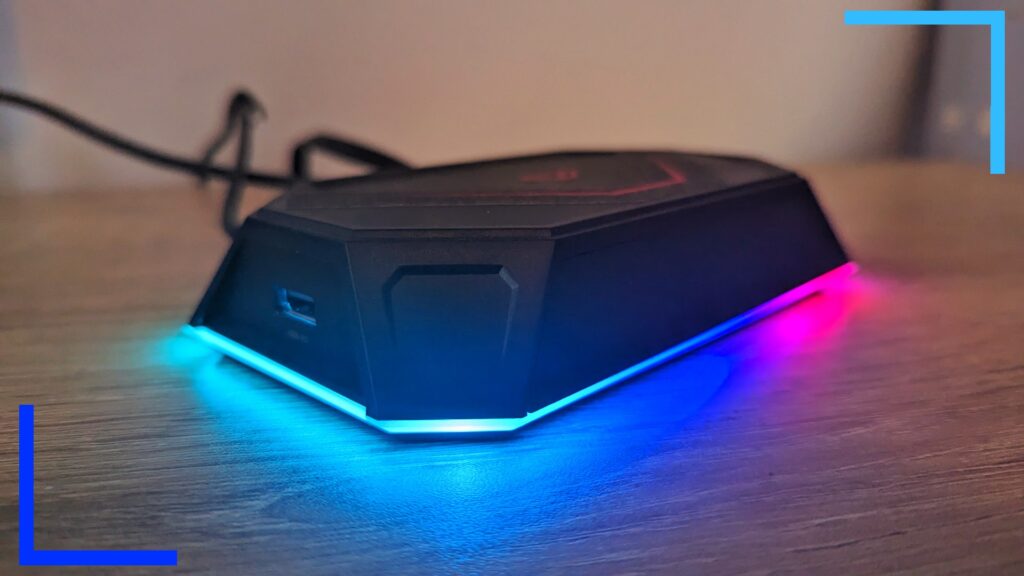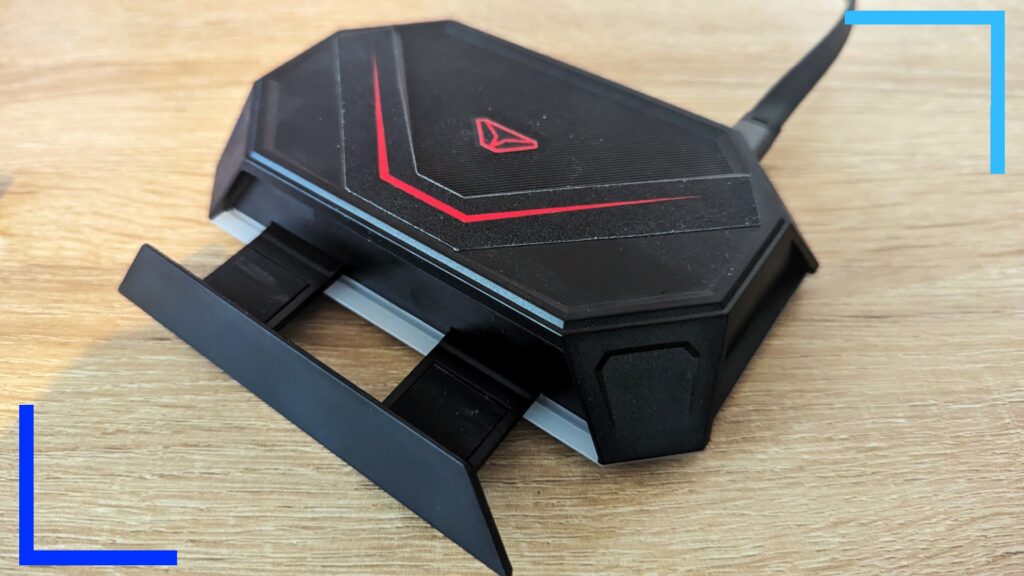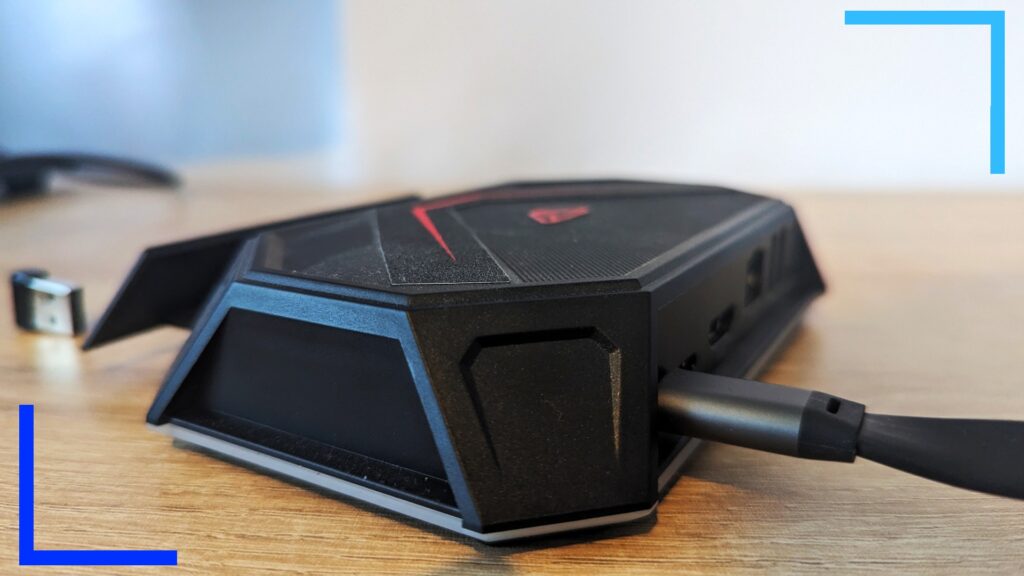Highlights.
- The JSAUX RGB dock is the company’s most stylish dock to date.
- RGB lighting works brilliantly.
- Pop-out tray helps to make the dock more compact.
- The USB-C cable is going to divide opinion.
- Two versions are available: The basic model comes in at $59.99, while the more advanced offering is $89.99.
- You can order the RGB dock on the JSAUX website or from most tech online retailers.
From Strength to Strength.

The design team at JSAUX deserves some serious credit. I don’t know how they keep managing to do this, but the company’s latest RGB dock is, once again, the best Steam Deck dock out there.
I still remember reviewing the first wave of JSAUX docks, which at the time were the best option, but now look dull when compared to the more exciting Omnicase 2 and the latest RGB dock.
Slick and Stylish.

It’s amazing how compact the RGB dock is. The pop-out tray won’t be for everyone, but as someone who uses their Steam Deck (and ROG Ally) in both docked and handheld mode, having the option to save a small amount of space is great.
The inclusion of OpenRGB is a smart choice as well. OpenRGB is available from the Discover store on Steam Deck and is ridiculously easy to use and offers a ton of customization options.
As far as fixed modes go, you’ve got six to choose from:
- Direct
- Breathing
- Rainbow Wave
- Spectrum Cycle
- Race Cycle
I’ll be the first to admit, some of these options are an eyesore. Race Cycle especially makes me feel like I’m going to end up with a migraine. If you suffer from epilepsy, I’d definitely pass on this one. The more soothing options, though, they’re great.
What I really like is how OpenRGB lets you change the individual color quadrants. Yeah, you read that right. The front, back, and both sides can be customized to whatever color you want. Want something that resembles rainbow vomit? You can totally do that! Or, if you’re me, you can set the dock to the RetroResolve colors. Don’t do that, though. No one should. It’s too nerdy.
You can learn more about how to get OpenRGB on other docked devices by reading this tutorial from JSAUX.
One thing that’s sure to divide owners is the use of a right-angled USB-C cable. The cable itself is excellent, with a rubber coating to help protect the wires inside. But that right-angled USB-C end that connects to the console is a pretty big misfire. On the Steam Deck, its size means you either end up with the rubber cable directly over one of the vents (rubber and heat aren’t a good mix) or you can angle it in the opposite direction and cover the power button, which, you know, you need to turn the thing on.
The USB-C isn’t fixed into the dock as they are with other JSAUX docks, though. So you can yank it out and change it to something less irritating. Still, there’s got to be a better way to do a USB-C cable that doesn’t get in the way of the console.
HB1201 vs HB0801.

As with most JSAUX products, the RGB docks have a letter and numerical name. In this case, you’ve got two different models – the HB1201 and HB0801 – and the main difference comes down to how many ports each model has.
I’ve got and tested out both models, by the way. Both rock, but I couldn’t get the pricier HB1201’s RGB off button to work. Hopefully, that’s fixed for the general release.
| JSAUX RGB Dock Different Models | |
| HB1201 | HB0801 |
| 6 RGB Lighting Modes | 6 RGB Lighting Modes |
| USB-A 2.0 (480Mbps) | USB-A 2.0 (480Mbps) |
| Gigabit Ethernet x1 (1Gbps) | Gigabit Ethernet x1 (1Gbps) |
| USB-C PDX1 (100W) | USB-C PDX1 (100W) |
| USB-A 3.2 x2 (10Gbps) | USB-A 3.0 x2 (5Gbps) |
| HDMI 2.1 (4K@120Hz) | HDMI 2.0 (4K@60Hz) |
| USB-C-3.2 (10Gbps) | USB-C 3.0 (5Gbps) |
| USB-C In | USB-C In |
| 3.5mm audio interfacex1 | Unavailable |
| TF card slot (480Mbps) | Unavailable |
| SD card slot (480Mbps) | Unavailable |
| DisplayPort 1.4 (4K@120Hz) | Unavailable |
| Price: $89.99 | Price: $59.99 |
Compatibility.
Both models of the JSAUX RGB dock are compatible with the Steam Deck, ASUS ROG Ally, OnexPlayer, AYANEO, AYN Odin, Razer Edge, and the Logitech G Cloud. So that’s pretty much all the best Windows handhelds and some of the Android options.
One thing to note: I used the included 65-watt charger with the ASUS ROG Ally and that isn’t enough to activate the full 30-watt Turbo Mode. The 25-watt Turbo Mode works fine, but for 35 watts you’ll need a 100-watt charger to power the dock. Thankfully, JSAUX is a forward-thinking company and made the dock capable of 100-watt power delivery. So as long as you’ve got a powerful enough charger, it should work with the ROG Ally in theory.
Verdict

I’m the type of person that likes bouchie gamer ware. RGB lights? I’m in. Pop-out tray? I am down. Just make the thing small so I’ve got more desk space, and make it so it sits nicely under my work monitor then I’m happy.
But what JSAUX keeps building and releasing goes further than that. The designers keep coming up with fresh, new ideas, and as a company, JSAUX is open to feedback regardless of whether it’s positive or negative. It’s a company that listens to its consumers, and if I’m being real, there aren’t enough places like that in the handheld scene
So, once again, JSAUX has made another killer product that – somehow – is better than anything that came before it. I don’t know when JSAUX’s run of good design choices will run out, but as a guy who loves when tech exceeds expectations, I hope it never ends.
All photos captured by RetroResolve. | Review units provided by JSAUX. | No affiliate links were used in this review.

